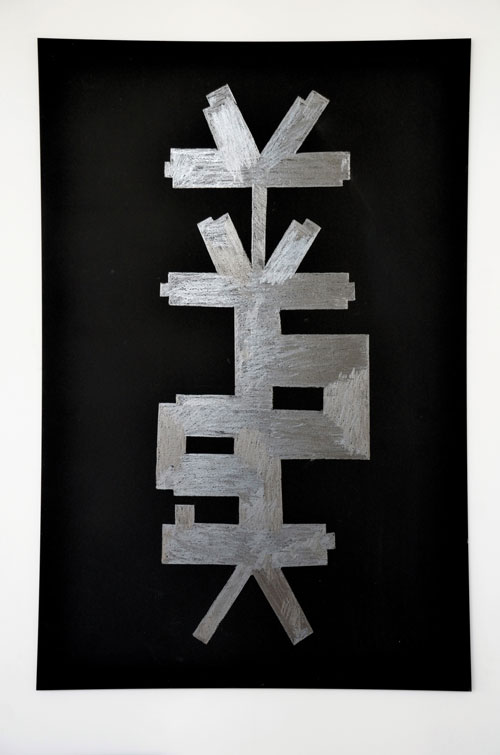Duron Jackson gives us a key to decipher his Blackboard Paintings (2010-2012), the most compelling parts of his installation “Rumination,” the latest of the Brooklyn Museum’s “Raw/Cooked” series. The wall text is that key, informing us that the enigmatic glyphs are prison aerial views: Riker’s Island in New York, River Junction in Florida, Pelican Bay in California, and several others.
The symbols are powerfully charged ideographs despite their abstracted, cool precision. It is right to call them ideographs, because these glyphs represent more than floor plans. They signify an entire socio-historical discourse that, when it has been heard at all, has often been rendered in the thunderous voice of denunciation: generations lost to prison, male impotence and rage, an invisible underclass, fear of the monster who comes in the night, brooding black bodies packed in cells, our culture’s inability to deal with those it cannot control and won’t control themselves, and the costs of having a civilized society. The paintings conceal these meanings behind cool surfaces of burnished silver-gray graphite on a matte, black wooden substrate. What they quietly signify is awful.
However, Jackson does not trust us to grasp the underlying sociopolitical history or the critiques of the prison industrial complex his visual symbols call up. That, or he does not trust his logographic language to clearly relate these meanings. He adds other pieces to point to the relation of the slave trade to black men’s current state of incarceration, but in doing so dilutes his most forceful statements. Included in “Rumination” is his didactic painting, a body print of a male figure tumbling head first, fiery red on white paper, Devils’ Exit (2007). The middle of the room, meant to invoke a parlor, is taken up by a throne-like chair covered in white ceramic dominoes sitting atop a contrasting dais made of black dominoes (Ruminations 2012). Finally, in case we still do not get that his references are to black bodies, he includes Malvina Hoffman’s representational bust titled Senegalese Soldier (1928), borrowed from the Brooklyn Museum’s collection. The head, slightly larger than life, has beautifully stylized African features. The premise of the “Raw/Cooked” series is that new artists might take inspiration from existing work in the museum’s collection. Here, that inspiration is manifested too literally.
Jackson fails to keep faith with his own symbols that have carved out sense from absence. His paintings are the strongest elements of the exhibition, reading as cuneiform communiqués broadcast from another sociohistorical reality, or the lost hieroglyphs of an extinct branch of the human family. Ultimately, he would have benefited from more restraint. Less needed to be said here. Too much of “Rumination” is his earnest attempts to generate serious contemplation using wizened metaphors. The truly unnerving question his abstractions raise (that appears over and over again in history) is: What happens to the unregulated body, when in our collective consciousness we attempt to make it disappear?

